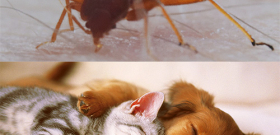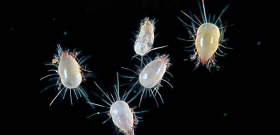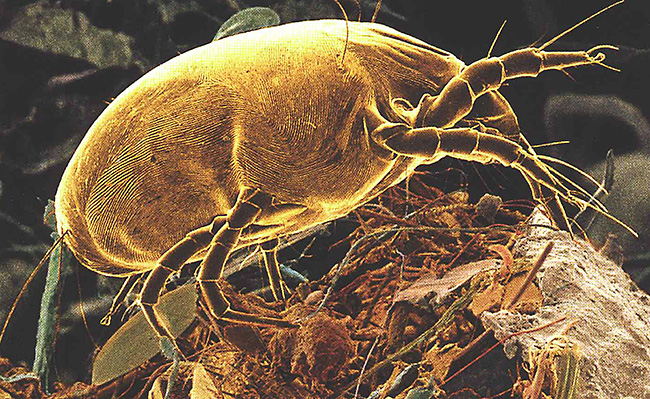
We answer the most common questions about ticks in the house.
Ticks in the house, especially those who live here all the time, seem like nonsense to many people. If cockroaches, moths and even bedbugs are perceived by many as undesirable, but still “domestic” arthropods, then people are used to being afraid of ticks only on the street, and they are sure that these creatures will definitely not appear in the apartment, and if they accidentally get in from the street , they certainly won't survive.
In fact, domestic, semi-domestic, and often not at all related to human housing, ticks are found in 87% of residential premises. Somewhere people cannot find them (but suffer from being close to them), somewhere they find them, but do not recognize them as ticks. But everywhere the neighborhood with them creates problems, and in some places - a threat to health.
Alexander Plotvitsky, junior researcher at the Anti-Plague Research Institute, answers the most frequently asked questions of our readers and subscribers about ticks that can be found in housing: where do they come from, what do they eat here, what are they dangerous for, and how to deal with them here?
Can ticks constantly live and breed in an apartment? They live only in the forest and in the meadows ...
In apartments and private houses, several dozen species of ticks constantly live, multiply and thrive.These are the so-called synanthropic species - those for which the conditions in human housing are optimal for life. At home, they often breed even faster and more successfully than in the wild, because here they have practically no enemies (at least until the person himself begins to purposefully destroy them).
The opinion that ticks can only live in the wild appears among people who are familiar only with ixodid ticks - parasites that feed on the blood of people and other animals, and indeed, breed only in the wild. If a dog, cat or person accidentally brings such a tick from the street, it will not die immediately, but it will not be able to breed here (although it can bite someone else). But ixodid ticks are just a small family in a huge subclass of ticks. Today, 700 species of ixodid ticks and more than 54,000 species of ticks have been described. And it is these "non-ixodid" ticks that inhabit our homes, consuming here different, often very specific foods.
What ticks can constantly live and breed in an apartment? What do they eat here?
If we sort all domestic ticks according to their prevalence in human housing, then our most frequent cohabitants will be:
- House dust mites, or simply dust mites. They live in close proximity to sleeping areas and feed on bits of skin that flake off humans. According to statistics for Europe, allergens emitted by dust mites are found in 68% of households. This means that out of three dwellings, two will be inhabited by these mites.
- Spider mites are plant pests that multiply rapidly on many indoor flowers and feed on juice from any above-ground parts of the bushes.
- Flat mites, or flat mites, which are also called false spider mites. They lead the same way of life as arachnids, but do not form cobwebs on plants.
- Barn mites are a "collective hodgepodge" of species of several families that specialize in feeding on various food products. There is an onion, flour, cheese and even wine mite - the latter feeds on the products of fermentation of wine on its surface in a barrel or bottle. And in other species, the names make it clear what they eat and where to look for them.
- Several species of gamasid and argas mites, parasitizing mainly on birds and synanthropic rodents. Breeding in the nests of pigeons, swallows, swifts, rats and mice, they often creep into living quarters and begin to bite people. Especially common in rural areas in old houses.
Also a very large group are parasitic mites, rigidly associated with the human body. This is, first of all, itchy itch and acne gland. The first lives in the human skin and feeds on it, the second settles in the hair follicles (most often on the eyelashes, for which it is commonly called the “eyelash” mite) and feeds on the fat secreted in the follicle. These mites cannot be called strictly “domestic”, because they live on a person, regardless of where the person lives. But in fact, almost all of their world population is concentrated in human habitation.
Are ixodid ticks found in homes? Can you get tick-borne encephalitis here?
Ixodid ticks cannot reproduce in human housing, so they can only get here by accident.
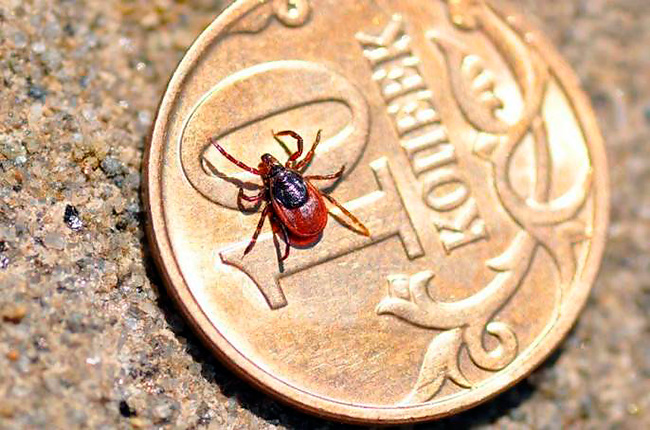
If such a tick stuck to a person or dog on the street, they brought it home on themselves, and here it detached itself, then it will try to find a secluded place where it can molt or lay eggs - depending on what stage of development and what sex this animal is. individual. Theoretically, nothing prevents such a tick from living here, and if it is an adult female, then it can even lay eggs here. Larvae will hatch from them that can bite humans and domestic animals, but basically they will all die, because there is no biotope necessary for them in housing: most ticks lie in wait for their victims, sitting on blades of grass, and they do not run and catch up with people or dogs with cats know how. Since they cannot hunt "from the grass" here, they mostly die. But before that, they can catch the eye and scare the homeowners.
In addition, small larvae of ixodid ticks attack mainly small animals - lizards, mouse-like rodents. A man, and even a dog, are too big for them, and their skin is too strong and rough.
The nymph of the forest tick, or adults who find themselves in an apartment, can live here for a very long time. They are able to starve for months, and in some species, individuals may even actively pursue potential hosts. Therefore, in principle, such introduced individuals can live in a house for weeks or even months and even bite people or animals.
At the same time, cases of attacks of ixodid ticks on people in apartments and houses are extremely rare. Cases of infection with tick-borne encephalitis or Lyme borreliosis from such "domesticated" ticks are not known at all.
Why are house mites dangerous?
All types of synanthropic ticks harm in different ways, but the consequences of their activity can be very serious.
Dust mites cause very severe allergies. Their digestive enzymes, capable of breaking down indigestible cells of the epidermis, are chemically very active, and if they enter the respiratory tract with dust, they cause rhinitis, which, if untreated, can provoke the development of bronchial asthma. According to statistics, 70% of children with bronchial asthma are allergic to the waste products of these ticks. It is believed that more than half of chronic rhinitis is caused by an allergy to dust mites. Dust mites are associated with many cases of atopic dermatitis and conjunctivitis.
Gamas and argas mites bite people and suck his blood. Their bites cause severe itching, skin irritation and provoke the appearance of a rash. Such symptom complexes are even distinguished into separate diseases - tick-borne dermatitis, or acariases. The stings of some tropical argasid ticks are so painful that they have been compared to wasp stings.
Barn mites can cause skin lesions if they get on it and bite a person. But it is considered more dangerous to get them into the digestive tract with food. Ticks can survive inside the stomach and intestines for a long time, burrow into tissues and cause inflammation and ulcers. Some species can even reproduce inside the human digestive tract and urinary tract. All this is accompanied by very unpleasant phenomena: the appearance of blood and pus in the stool, a feeling of itching and pain in the anus, malaise, allergic reactions, and abdominal pain.
Similarly, some types of mites can penetrate the organs of the genitourinary system and cause urinary acariasis with damage to the kidneys, bladder and urinary tract.
Spider and flat mites severely damage plants and, if severely infested, lead to the death of the affected bushes.
You can’t even talk about the scabies mite and iron glands - they are known precisely for the diseases that they cause: scabies and demodicosis.
How to understand if it is ticks, or someone else?
The easiest way to tell ticks apart from any other arthropods is to count the number of legs they have. Ticks always have 8 legs (with the exception of larvae, which cannot be seen with the naked eye and count the legs), other domestic arthropods have a different number. For example, all insects have 6 of them (and caterpillars, for example, moths - 16, taking into account false abdominal legs), centipedes - several dozen, wood lice - 14. Spiders also have eight legs, but it is quite easy to distinguish ticks from spiders by the shape of the body and the length of the legs themselves: the legs of spiders are much longer, and the body is usually rounded, with an abdomen clearly separated from the head.
For example, here in the photo is a settlement tick:
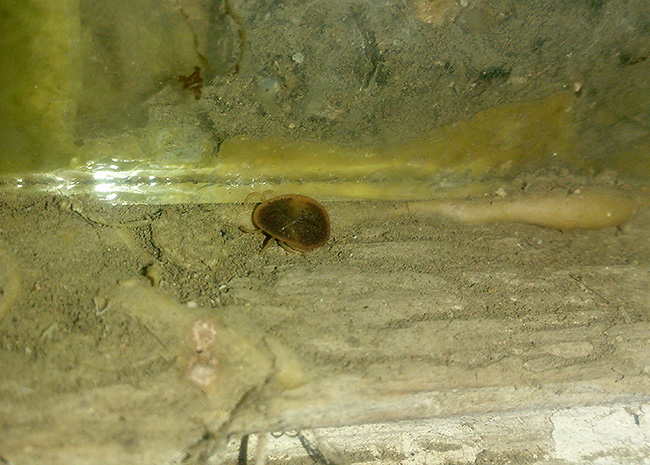
And here is an ordinary cross-spider:

The location of the legs on the body of ticks is also characteristic: the front two pairs are usually directed forward and are located in front of the head.
The problem in identifying most ticks is due to their small size. For example, the same spider mites, it seems, can be seen with the naked eye, but their legs can only be counted with a powerful magnifying glass, or a microscope. For these purposes, even a school or children's microscope is suitable, and some phones in macro mode can take a clear photo, in which, when approaching on a computer, you can clearly see the legs.
However, some mites are indistinguishable to the naked eye, and without special devices, they cannot be seen or identified. For example, dust mites and most barn mites have a body that is a fraction of a millimeter long, and you won’t be able to see them, let alone count their legs, without a microscope.
And how to determine which ticks I have at home?
Determining the species of ticks, even if they are not microscopically small, is difficult, and for a non-specialist it is almost impossible.
For example, even fairly large argas and gamasid mites are outwardly very similar, and it is simply impossible to distinguish them from each other by sight with the naked eye. The larvae and small nymphs of ixodid ticks are quite similar to them, and therefore even a specialist cannot always at first glance unequivocally say which particular ticks are in front of him.
It is definitely impossible even to say that if the tick is red, or only with a red backside, then this is a blood-sucking parasite. In private houses, predatory red-calf mites can live, which do not bite people, but prey on small insects, and therefore are even useful to some extent.
To some extent, accurate identification can be made by the location of the ticks and the behavior of the ticks:
- If the parasites are visible to the naked eye, bite people, or are clearly filled with blood, then these are either argas, or gamas, or ixodid ticks.
- If the mites are on plants, or in flower pots in general, and crawl along small, plaque-like cobwebs, then these are spider mites.
- If ticks are on plants, but there is no cobweb, then these are flatworms.
- Ticks, in the mass crawling on food - barn.Accordingly, flour mites are most likely to be found on groceries, bulb mites on onions, wine mites on the surface of wine, and cheese mites on cheese. But here everything is not entirely clear: flour mites, in the absence of other food, can damage, for example, cheese, or bite a person.
- The mites that we managed to see under a microscope on the carpet, carpets, on the bed, in the dust, on the baseboards, in the corners of the room are most likely dust mites.
Be that as it may, not a single type of tick is useful in an apartment. If you find any of them in your house, destroy them.
I see either a fly or a tick, and I can’t understand who it is ...
Most likely, this is a fly from the bloodsucker family. It's not a tick, although it looks and moves like ticks. She has a flat body, and the movement of her legs is similar to a tick-like "gait".
If the fly still has wings, then this is the most reliable distinguishing feature. Some bloodsuckers, after falling on the host's body (birds, humans, dogs), bite off their wings, which prevent them from moving in their hair or feathers. However, it is not difficult to count their legs and make sure that there are six of them, and this is really a fly.
Where do these mites come from in the apartment?
Different ticks enter housing in different ways.
Argas and gamasid mites usually breed in bird nests in attics and walls, or in mouse and rat burrows in basements. From here, they can spread themselves to the adjacent premises. Moreover, their small size allows them to climb even into the narrowest cracks, which is especially dangerous in wooden houses, where ticks can accumulate in huge quantities in the cracks between the boards.
Some types of these ticks - chicken, pigeon, some other types of bird ticks - can breed in aviaries with poultry and in chicken coops, and from here they can already move to a private house.
Barn mites enter a person's home most often with contaminated products, very rarely - on clothes, or on the integument of a person's body, if he works in food production and comes into contact with the same contaminated products there.
Dust mites spread to new premises on clothes, shoes, personal belongings, transported furniture, appliances, and especially carpets. They are very small, and in a few minutes several individuals with dust can get on trousers or a shirt lying on the carpet, which will safely move to a new room on these clothes, crumble to the floor and begin to breed safely.
Can all these mites breed in the house?
Ticks can breed in the house, which at all stages of development can find food here.
In particular, dust mites, barn mites, spider and flat mites, and several types of argas and gamas mites normally breed in an apartment - those that can feed only on humans or on ornamental birds indoors.
Most argas and gamasid mites, including "bird" and "mouse" mites, cannot breed in an apartment, since in the early stages of development their larvae and nymphs cannot feed on humans. Even if adults, the largest individuals, are able to pump blood from a person, their larvae cannot pierce the skin and get to the blood, and therefore die. Their reproductive cycle is interrupted.
Ixodid ticks, including vectors of tick-borne encephalitis, cannot breed indoors.Theoretically, individual female species of the genus Hyalomma can fall away from dogs in their booths, or beds, hide in nearby crevices to lay eggs here, and the hatched larvae will attack the same dog. All this is possible due to the fact that ticks of this genus can actively pursue their prey. However, there were no real cases of mass and constant reproduction of such ticks in a residential area. In the yard near the house, such ticks breed in the same way as representatives of other genera of the ixodid family, and it is never possible to understand whether their reproduction is limited only to an infected doghouse.
And if a tick fell from a dog in a house, how long can it live here and will it bite someone?
The ixodid tick can live in an apartment from several days to several months, depending on its stage of development and gender. It depends on these same factors whether he will bite someone.
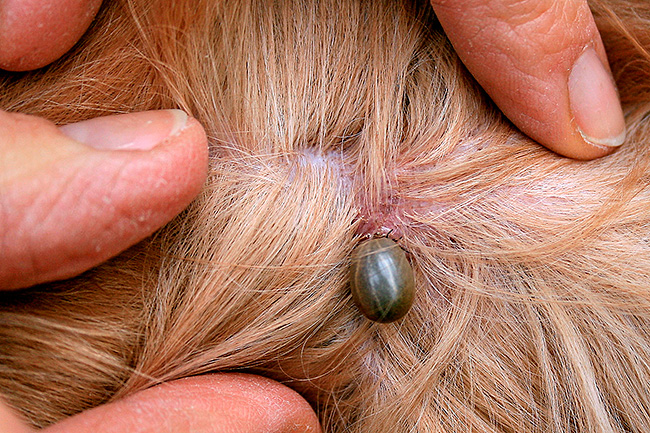
If the tick was an adult, then after detaching from the dog, it most likely will not bite anyone. If this is a female, then she will lay eggs somewhere in a secluded place, and die. The male will try to hide, maybe even try to find a new host, and will either catch the eye of people or die in a few days or weeks.
If the tick was a nymph, it may molt into a nymph of the next age, or into an adult, after which it will again try to find the host and cling to it. He can even succeed, but he definitely won’t be able to find a sexual partner in the apartment and leave offspring.
How to find such a fallen off tick in the apartment?
It is very difficult - the tick is small, and always looks for very narrow and secluded shelters after detaching from the host.You can inspect the bedding on which the pet sleeps, unfasten and inspect the skirting boards, unscrew the edges of the linoleums. But it is unlikely that such measures will help to find one tick in the apartment - this is a task of about the same level of complexity as looking for the notorious needle in a haystack.
How to get these ticks out of the apartment?
All mites are quite effectively destroyed by acaricides based on pyrethroids and organophosphorus compounds. Spider mites and flathead mites can be resistant to some substances of these groups, and if some drug does not work on them, it is necessary to re-treat their habitats with a product based on a different acaricide. At the same time, many preparations based on avermectins and compounds that have a hormonal effect on ticks work well against spider and flat mites.
Argas, gamas and dust mites in the vast majority of cases are quickly etched out by the most common household insecticides based on organophosphorus compounds and pyrethroids.
Some difficulty in the destruction of dust mites is that they are practically invisible, which makes it difficult to assess the result of the work. However, practice shows that a single disinfection of the premises followed by regular (once a week) thorough cleaning is enough to get rid of these pests.
After baiting dust mites, their dried excrement containing allergens may remain in the room. There are special sprays that, when sprayed on dust containing such allergens, decompose them into harmless forms. However, from a practical standpoint, thorough cleaning with vacuuming, mopping, and scrubbing crevices behind skirting boards removes 90-95% of these allergens from a room.If the mites themselves have been etched and no new excrement is left, then after 2-3 such cleanings there will be no allergens in the room.
Ticks that infect food are thrown away with the food. If such contaminated products are found, after discarding them, it is advisable to thoroughly clean, vacuum and wash the cupboards and pantries where these products were stored in order to destroy possible egg clutches and single individuals that have spread on the surfaces.
And what to do so that this muck does not appear in the house anymore?
Practice shows that it is necessary to protect an apartment mainly from argas, gamas and dust mites.
To protect against argas and gamasid mites in a private house, it is necessary to eliminate bird nests in attics, burrows of mice and rats in the basement. Mice can be caught with traps and sticky traps, and from pigeons and starlings, close windows in the attic with bars.
In an apartment building, the attic is also closed with nets on the windows, and deratization is regularly carried out in the basement. If it is not possible to carry out such work, you need to take care of the insulation of the apartment - put reliable mosquito nets on the windows, putty cracks and holes in the outer walls, eliminate the gaps between the pipes of engineering networks and concrete structures. In general, the task here is to make sure that ticks cannot physically crawl into the apartment.
It is impossible to reliably protect yourself from dust mites, but regular cleaning of the room is a good prevention of their reproduction. A powerful vacuum cleaner draws in almost all mites along with dust, and even if there are several “pioneers” in the apartment, they and their descendants will die in the vacuum cleaner cyclone during one of the subsequent treatments.
Barn bugs enter the apartment with contaminated products, and therefore the best way to prevent such an infestation is to buy quality products in reliable packaging. And, of course, maintain cleanliness in the places where these products are stored.
Finally…
In general, synanthropic mites represent a much smaller sanitary problem than, for example, synanthropic insects - cockroaches, bedbugs, ants. At a minimum, ticks are not as mobile, and are more likely to spread thanks to the person himself. We can say that ticks in an apartment are in most cases a consequence of a violation of elementary sanitary rules: rare cleaning, accumulations of rubbish and old products, dilapidation of the room itself. Therefore, if you simply keep the house clean and in good technical condition, ticks will most likely not appear here, and even if they are accidentally infected, it will be easy to remove them.

